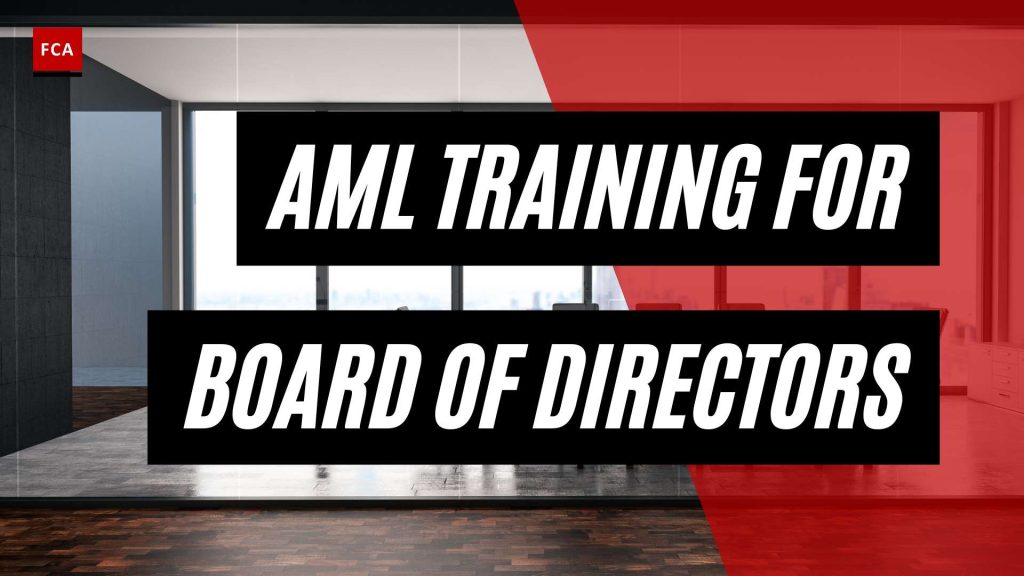Essential AML Training for Directors
The landscape of financial crime is constantly evolving, necessitating a robust Anti-Money Laundering (AML) training program for all levels of an organization, especially the board of directors.
Importance of AML Training
AML training for the board of directors is a vital component of regulatory compliance, and it should be scheduled at least annually (Financial Crime Academy). The training should cover a comprehensive range of topics, such as financial crime prevention, specific money laundering risks facing the company, and legal and regulatory requirements. Not only does this enable board members to fulfill their responsibilities, but it also equips them with the knowledge to avoid personal liability in cases of non-compliance.
Appropriate AML training provides an in-depth understanding of the risks and potential red flags associated with money laundering activities. It empowers board members to recognize suspicious activities within the company, ensure compliance with related laws and regulations, and respond effectively to any compliance failures that may arise.
The importance of AML training for senior management and the board of directors cannot be overstated. A proactive approach not only enhances the organization’s overall compliance framework, but it also helps to mitigate the risks associated with financial crime, including money laundering, terrorist financing, and other illicit activities.
Consequences of Inadequate Training
Inadequate AML training can have severe repercussions for the company and the board of directors. These consequences may include financial penalties, reputational damage, legal actions, and the erosion of customer trust. The personal liability of board members who fail to meet their compliance obligations is also a significant concern (Financial Crime Academy).
In an era where financial crimes are increasingly sophisticated, the importance of comprehensive and effective AML training for high-level executives cannot be underemphasized. By ensuring that the board of directors is well-equipped with the necessary knowledge and skills, companies can better protect themselves against the risks of money laundering and the potentially devastating consequences of non-compliance.
Tailoring AML Training
Customizing Anti-Money Laundering (AML) training according to the specific requirements of the industry and jurisdiction in which the company operates is crucial. This approach to training can provide practical guidance on how to identify and mitigate money laundering risks associated with specific business activities Financial Crime Academy.
Industry-Specific AML Training
AML training for the board of directors should be designed to address the unique risks associated with their specific industry. Different industries may face distinct sets of challenges and risks when it comes to money laundering. For instance, the financial sector might have different areas of focus compared to the real estate or the art industry.
High-risk roles, such as relationship managers or employees in payment processing teams, play a crucial role in identifying suspicious activities related to money laundering. Training for these individuals should be tailored to the specific activities unique to their roles and the risks they face. This could involve role-based training solutions which are beneficial in creating a more effective and impactful training experience International Compliance Association.
Jurisdiction-Specific AML Training
The jurisdiction or geographical area where the company operates significantly influences the AML regulations it must adhere to. These regulations define the AML training requirements for board members and other employees. For example, in the UK, the Money Laundering, Terrorist Financing and Transfer of Funds Regulations 2017 (MLR2017) require employees to be ‘made aware of the laws relating to money laundering and terrorist financing. This awareness can be disseminated through various methods such as mandatory online learning International Compliance Association.
The MLR2017 mandates regular training on recognizing and handling transactions and activities linked to money laundering or terrorist financing. This requirement underscores the need for continuous education and awareness regarding these financial crimes International Compliance Association.
In order to ensure that the AML training for board of directors is effective, it should be updated regularly to reflect any changes in the legal framework or evolving money laundering tactics. The training should also be tailored to the specific risks faced by the firm, which can be identified through a risk assessment. The Financial Conduct Authority (FCA) has emphasized this aspect of AML training, citing instances where a lack of training or insufficient staffing impacted employees’ ability to perform their roles effectively International Compliance Association.
In conclusion, tailored AML training that takes into account industry-specific and jurisdiction-specific aspects is crucial for effective risk management and legal compliance. It allows for a more targeted approach in combating money laundering and terrorist financing activities, making it a key component in building a resilient frontline in the fight against financial crime.
Key Focus Areas in AML Training
For the Board of Directors, Anti-Money Laundering (AML) training should be comprehensive, covering everything from recognizing potential risks to understanding the legal implications of non-compliance. Two key areas that should be emphasized in the training are recognizing red flags and understanding the importance of regulatory compliance and reporting.
Recognizing Red Flags
One of the primary objectives of AML training for Board of Directors is equipping the members to recognize red flags of money laundering. This involves understanding the various methods of money laundering, typical patterns of suspicious behavior, and potential risks within the organization. By being able to identify these red flags, board members can play an active role in mitigating the risks associated with money laundering.
Training programs should include specific examples of money laundering and suspicious activity that are tailored to each operational area. For instance, training for tellers might focus on recognizing large currency transactions or suspicious activities, while training for the loan department should provide examples involving money laundering through lending arrangements.
High-risk roles, such as relationship managers or employees in payment processing teams, play a crucial role in identifying suspicious activities related to money laundering. Training for individuals in these positions should be tailored to the specific activities unique to their roles and the risks they encounter. For more information on tailored training solutions, check out our article on role-based AML training solutions.
Regulatory Compliance and Reporting
In addition to being able to recognize potential risks, board members should also have a thorough understanding of the regulatory environment and the legal implications of non-compliance. This includes a clear understanding of the organization’s obligations under the Bank Secrecy Act (BSA), Anti-Money Laundering (AML) regulations, and other relevant laws.
Management should be well-versed in the organization’s reporting requirements, including how to properly file Suspicious Activity Reports (SARs) and Currency Transaction Reports (CTRs). They should also understand the importance of maintaining a robust compliance program and the potential legal and reputational consequences of non-compliance.
AML training for the board of directors should focus on managing and reporting on suspicious financial activity, reducing fraud losses, and protecting customers. Training can also form part of a remediation plan to address issues identified in business operations, ensuring that employees have the necessary skills to perform their roles effectively (International Compliance Association).
For more information on the importance of regulatory compliance in AML training, refer to our article on AML regulations for senior management.
Role of AML Training in Risk Management
The role of AML training in risk management cannot be overstated. A proactive approach to AML training for the board of directors not only enhances the company’s overall compliance framework but also helps mitigate the risks associated with financial crime, including money laundering, terrorist financing, and other illicit activities (Financial Crime Academy).
Strategic Planning and AML Risks
AML training for senior management and board members should aim to improve strategic planning. By understanding the intricacies of AML regulations and their implications for the organization, board members can optimize the AML program, anticipate future growth and risks, and gain a competitive advantage. This level of strategic planning can help in identifying and monitoring risk to ensure compliance.
Additionally, a successful AML training for high-level executives should focus on simplifying loan management and automating the entire life of the loan to identify and monitor risk. This can help in booking more loans faster, thereby boosting income and lowering risk.
Adopting Technology for AML Compliance
In the digital age, technology plays a crucial role in AML compliance. As such, AML training for board of directors should also cover the adoption of technology to maximize return on investment. This might involve the use of artificial intelligence and machine learning in detecting suspicious activities, automating reporting processes, and streamlining customer due diligence checks.
Moreover, AML experts can provide outsourced assistance with alerts, cases, lookbacks, and more, while experience across hundreds of CECL filers can help in stress-free CECL transitions (Abrigo).
It’s important to note that the effectiveness of a bank’s compliance program is taken into consideration by bank examiners, prosecutors, and sentencing judges, and can influence charging decisions and assessment of corporate fines and penalties. Therefore, ensuring effective AML training for executive leadership is not just a best practice—it’s a legal necessity.
By integrating AML training into strategic planning and leveraging technology for compliance, organizations can build a resilient frontline against financial crimes. For more information on AML training for senior management, check out our AML training workshops.
Ensuring Effective AML Training
For an AML program to be successful, it’s not enough for board members to just undergo initial training. The rapidly evolving landscape of financial crime necessitates continuous learning and updates. In this section, we will explore the importance of regular updates and refresher courses, as well as the significance of role-based training solutions.
Regular Updates and Refresher Courses
AML training for board of directors should include regular updates and refresher courses to ensure that board members stay informed about evolving threats, emerging trends, and regulatory changes in the financial crime landscape (Financial Crime Academy).
Ongoing education and awareness-building efforts are essential to keeping board members informed about current developments and changes to BSA regulatory requirements, supervisory guidance, internal policies, procedures, processes, and the bank’s products, services, customers, and geographic locations.
The FCA emphasizes the importance of providing regular training, considering the risks faced by the firm. Annual refresher training for all employees, along with more targeted training for high-risk roles based on a risk assessment, is a common approach.
For a comprehensive understanding of these requirements, board members may consider attending our senior management AML training workshops.
Role-Based Training Solutions
Tailoring AML training to specific roles within the organization is another approach to ensuring effective training. This method ensures that employees have the necessary skills to perform their roles effectively. Role-based training formed as part of a remediation plan can address issues identified in business operations, preventing potential compliance issues and demonstrating a commitment to AML practices (International Compliance Association).
Board members, in particular, play a crucial role in setting the tone for the organization’s commitment to combating financial crime. Therefore, it is essential for them to understand their role in AML compliance and to have the skills necessary to provide effective oversight and guidance. A comprehensive understanding of AML regulations and guidelines is crucial for board members and can be achieved through our AML training for senior management courses.
By ensuring that AML training is updated regularly and tailored to the roles within the organization, board members can stay informed about the evolving landscape of financial crime and their responsibilities in mitigating these risks. This commitment to continuous learning and improvement is a key aspect of effective AML compliance.
Legal Obligations and AML Compliance
Understanding the legal framework surrounding AML training and the potential consequences of non-compliance is crucial for the board of directors in fulfilling their duties and mitigating risk.
Legal Framework for AML Training
The legal framework mandates that Anti-money laundering (AML) training for the board of directors should be scheduled at least annually. This training should cover a range of topics, such as financial crime prevention, specific money laundering risks facing the company, and legal and regulatory requirements.
Training should also be tailored to the specific industry and jurisdiction in which the company operates, providing practical guidance on how to identify and mitigate money laundering risks associated with the business activities (Financial Crime Academy).
Moreover, the Bank Secrecy Act (BSA) requires the board of directors and senior management to receive foundational training and stay informed of changes and new developments in the BSA, including its implementing regulations, the federal banking agencies’ regulations, and supervisory guidance (BSA/AML Manual). Without a general understanding of the BSA, it is more difficult for the board of directors to provide adequate oversight of the BSA/AML compliance program.
Potential Legal Consequences of Non-compliance
Inadequate AML training for the board of directors can result in severe consequences. These include financial penalties, reputational damage, legal actions, and the loss of customer trust. It can also lead to personal liability for board members who fail to meet their compliance obligations.
Board members of financial institutions are required to adopt and implement a BSA/AML compliance program. This includes setting the right tone at the top, providing adequate staffing and resources, staying informed, and ensuring proper monitoring and independent testing.
Failure to comply with these requirements can lead to regulatory sanctions, legal actions, and reputational damage. Therefore, it’s crucial for the board of directors to take a proactive approach in managing their AML obligations.
For more information on AML training for senior management and AML training requirements, visit our dedicated articles. To learn more about building a compliant AML framework, check out our article on implementing a BSA/AML Compliance Program.
Building a Compliant AML Framework
When it comes to Anti-Money Laundering (AML) compliance, it’s crucial to have a robust and effective framework in place. This involves implementing a Bank Secrecy Act (BSA)/AML Compliance Program and understanding the roles and responsibilities of board members.
Implementing a BSA/AML Compliance Program
The Board of Directors and senior management should receive foundational training and be informed of changes and new developments in the BSA, including its implementing regulations, the federal banking agencies’ regulations, and supervisory guidance. This training should provide board members with sufficient understanding of the bank’s risk profile and BSA regulatory requirements.
Without a general understanding of the BSA, it’s more difficult for the board of directors to provide adequate oversight of the BSA/AML compliance program, including approving the written BSA/AML compliance program, establishing appropriate independence for the BSA/AML compliance function, and providing sufficient BSA/AML resources.
Periodic training for appropriate personnel should incorporate current developments and changes to BSA regulatory requirements, supervisory guidance, internal policies, procedures, processes, and the bank’s products, services, customers, and geographic locations.
Training programs should include examples of money laundering and suspicious activity monitoring and reporting that are tailored to each operational area. For instance, tellers’ training should focus on examples involving large currency transactions or suspicious activities, while the loan department’s training should provide examples involving money laundering through lending arrangements (BSA/AML Manual).
It’s important that banks document their training programs, maintain the training materials, records, and attendance records, and ensure that the training content is available for auditor or examiner review.
Roles and Responsibilities of Board Members
Board members of financial institutions have a duty to adopt and implement a BSA/AML compliance program that includes tone at the top, adequate staffing and resources, staying informed, and monitoring and independent testing.
Board members have a duty to actively monitor corporate performance and oversee the corporation’s operations, including compliance programs, to detect potential violations of law, regulations, or corporate policy.
Board members may face individual civil and criminal liability for oversight failure, including claims for breach of fiduciary duties and prosecution by the Department of Justice.
The effectiveness of a bank’s compliance program is taken into consideration by bank examiners, prosecutors, and sentencing judges, and can influence charging decisions and assessment of corporate fines and penalties (Troutman).
In essence, board members are ultimately responsible for ensuring that the bank has a comprehensive and effective BSA/AML compliance program and oversight framework that is reasonably designed to ensure compliance with BSA/AML regulation.
For more detailed information on AML training for board of directors, you can explore our comprehensive resources on aml training for senior management and senior management aml compliance training.








